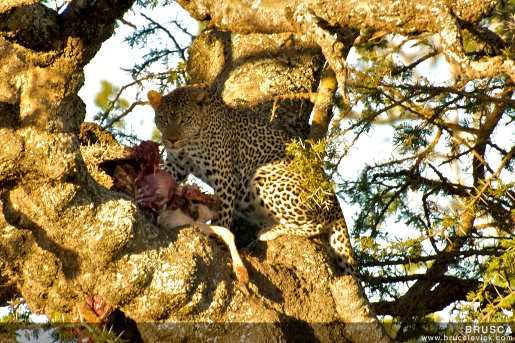Ngorongoro Crater can change the way you look at the natural world.
As a safari destination it seems fictional. Some 30,000 wild mammals occupy an extinct volcanic caldera in northern Tanzania. And they represent almost all the most iconic African animals.
From the very first moment you can see that this is not purely a wildlife refuge. No, Ngorongoro Crater feels like a utopia where humans can never be more than visitors. Perhaps nowhere in Africa is as magical.
This article will first explain why Ngorongoro Crater is so important. It then provides some very practical tips for planning a safari in Ngorongoro.
Note, this article is not intended to be a definitive guide. There is nothing definitive about a wildlife realm as pure as Ngorongoro. Instead, you simply need to be in the right place at the right time to maximise the safari experience.
(author’s note – I first visited Ngorongoro Crater in 2012 and have visited on more than a dozen occasions over the last six years)
Where and What is Ngorongoro Crater?
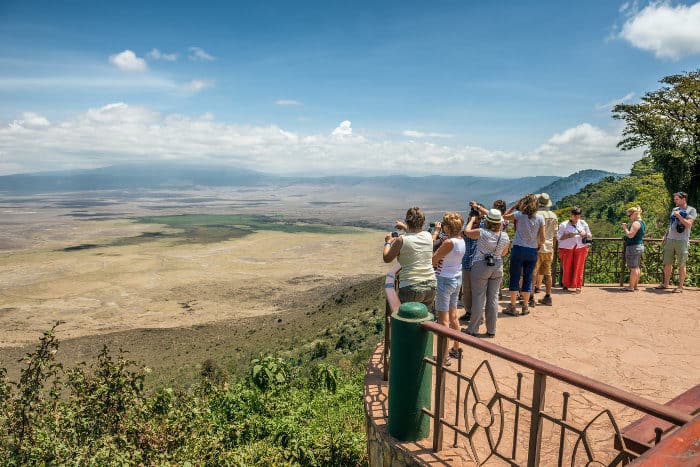
The crater is one of a string of volcanoes that pierce the horizon in northern Tanzania. It is around 300 km due west of Mount Kilimanjaro, another ancient volcano.
Ngorongoro Conservation Area is Tanzania’s most visited safari destination. It is the centrepiece in Tanzania’s Northern Safari Circuit, linking Lake Manyara and Tarangire with Serengeti National Park. Read more about Tanzania safaris here.
Almost every overland safari in northern Tanzania will pass through Ngorongoro. In 2016 the number of annual visitors reached 600,000!
In one sense the crater has not visibly changed since 2012. In another sense it is changing at an astonishing speed.
The Ngorongoro Crater Safari Experience
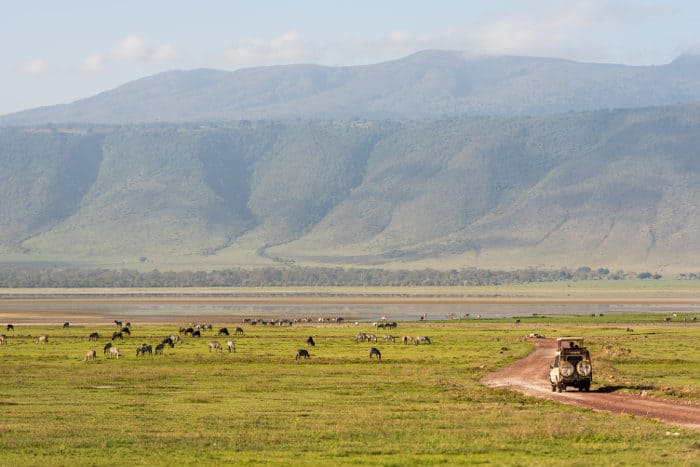
The crater
You can tell this is a volcano. From the ridge you can almost picture a time of bubbling lava. The caldera is almost entirely circular and you can usually see from one side to the other.
Not that this is a small place. Ngorongoro is the world’s largest intact volcanic caldera (it is erroneously called a crater).
How do you get into a volcano? Via an incredibly steep zigzag four-wheel drive trail. It is pretty scary, especially the first time.
Six different ecosystems occupy this single caldera. This means there is food for just about any animal that can descend the steep slopes.
The animals
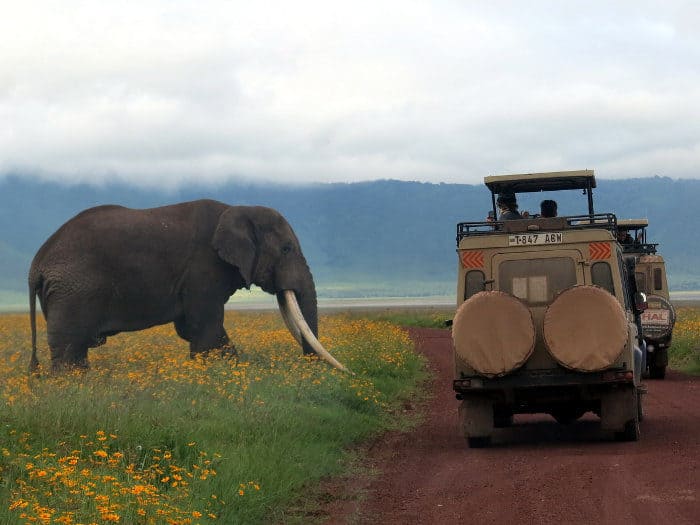
Lone elephant bulls wander past. They are giants, with tusks that curl skywards and hang above the vehicle. These are some of Africa’s largest elephants. The crater is like a retirement home for old bulls who have the size to impress, yet not the heart to battle each other.
Lions lounge around the crater floor, usually in the open. They are commonly encountered hunting during the dawn hours. If not hunting, these lions can be regularly seen tucking into the carcass from a successful nighttime hunt. If you visit Ngorongoro Crater and don’t see lions then you need a new safari guide.
Cape buffalos cluster in small herds all across the crater floor. Wildebeest do the same, their galloping and rutting bringing an infectious energy to a morning drive.
One lake is carpeted pink by flamingos. Another lake is dominated by the grumpy and rumbustious antics of hippos.

There are only a few black rhinos. But these shy creatures are easy to spot on the open caldera floor each morning. Leopards do live in Ngorongoro but are mostly nocturnal. It is very unlikely you will see one on a game drive (author’s note – I have only seen one leopard in more than 12 visits).
Hyena scamper around and seem to occupy every vista. Zebra stripes contrast the distinct frames of Grant’s gazelle. Eland stick to the crater fringes, sometimes grazing with waterbucks.
Thomson’s gazelle skip about as well, their movements followed by serval and jackals. The only famous animals you will miss are giraffe and cheetah. Giraffe legs are too long and spindly to descend into the crater, while cheetah appear to have been scared off by the profusion of other predators.
The experience
On any safari you will never see animals in isolation. They are always interacting, either within a herd or troop, or with other species. It is interactions that make a safari so special.
In Ngorongoro Crater these interactions are more profound than anywhere else. Sometimes there is so much going on you do not know where to look.
On one side there is both a hyena and jackal seeking to steal from a lion pride. Turn around and a rhino scampers past. Further away you can see hippos grazing, elephants wandering, and too many zebra to count.
Sometimes you can be so engrossed in a particular animal or scene, that you do not even realise that lionesses are just 20 metres away. Sometimes you gaze across the caldera floor and can see more than ten species in a single panorama.
With a Ngorongoro safari it feels like you have entered their world. It feels as if you are exploring a wildlife utopia that has existed since the dawn of time.
Imagine planet earth many hundreds of years from now. Imagine that there is no wildlife, just humans and their structures.
Now, imagine you had to educate a child on all those animals that used to live on earth. Well, you would probably draw a picture that looked just like Ngorongoro Crater, a wildlife party basking beneath the sun.
The downside
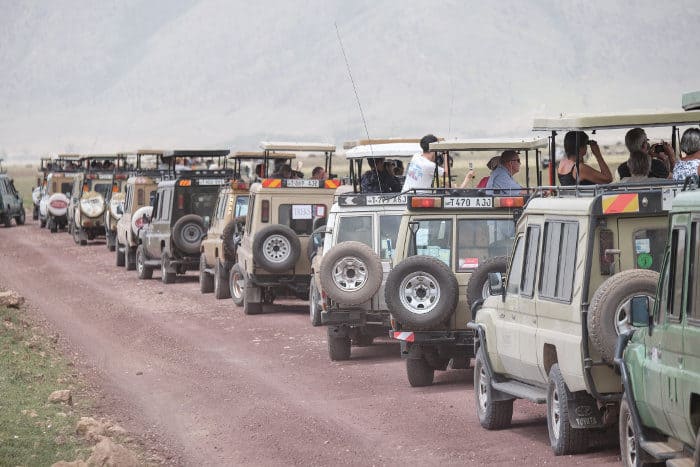
For 12 hours every day there is nothing but wildlife in Ngorongoro. Then for 12 daylight hours you will also see safari vehicles.
The Ngorongoro Crater floor is wonderful because you can see thousands of animals in a single vista. However, on such an open landscape you can also see every safari vehicle in a single glance.
This is also a destination that can put people off going on safari. More than ten trucks crowd around a lion. Sometimes you can’t see the elephants for the vehicles.
All these visitors and vehicles take away from the magical atmosphere. You can sense that humans can only be visitors. But too many visitors can turn the crater into a theme park.
Visit at the wrong time and Ngorongoro does not feel that special and the experience is nowhere near as profound.
Planning the Best Ngorongoro Crater Safari
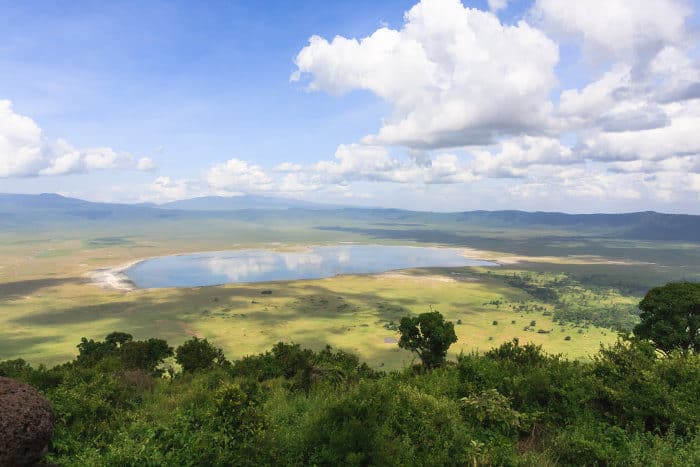
Understand where you are going
Ngorongoro Conservation Area is a large wilderness area bordering Serengeti National Park. It is home to many of the Masai people who were moved off their traditional Serengeti homelands when it was gazetted as a national park (people are not allowed to live in Tanzania’s national parks).
Ngorongoro Crater is located inside Ngorongoro Conservation Area. One road cuts through the conservation area, connecting the Serengeti with destinations like Lake Manyara, Tarangire, Moshi, Arusha and Kilimanjaro. A rough four-wheel drive track circles most of the crater.
The entire Ngorongoro Conservation Area is also protected as a World Heritage Site.
Know the rules relating to all visitors

You need to pay a conservation fee just to visit the conservation area, even if you are not visiting the crater.
On most overland safaris you must pay this fee twice. Once on route to the Serengeti, then a second time on the way back to Arusha or Moshi.
There is no additional fee for visitors choosing to visit the crater. However, every vehicle needs a special permit. As of 2019 this permit costs USD 295 per vehicle per entry.
Note that it is virtually impossible to drive your own vehicle in Ngorongoro Crater. For foreign registered vehicles the permit is something stupid like USD 2000! Permits are usually refused for Tanzanian registered rental vehicles but you could possibly sweet talk a way in.
Vehicle access (with a permit) and game drives are only permitted during daylight hours. Driving anywhere in the conservation area is not allowed after dark. The gate opens at sunrise and closes at sunset.
There is one main road in (located on the west of the crater). And there is only one main road out (in the northeast). This road out can also be used by descending vehicles during the mornings.
All game drives must stick to defined trails – there is absolutely no off-road driving here. Officially, vehicles can only spend six hours in Ngorongoro Crater. However, this is not routinely inspected by park officials.
How Ngorongoro Crater changes through the day
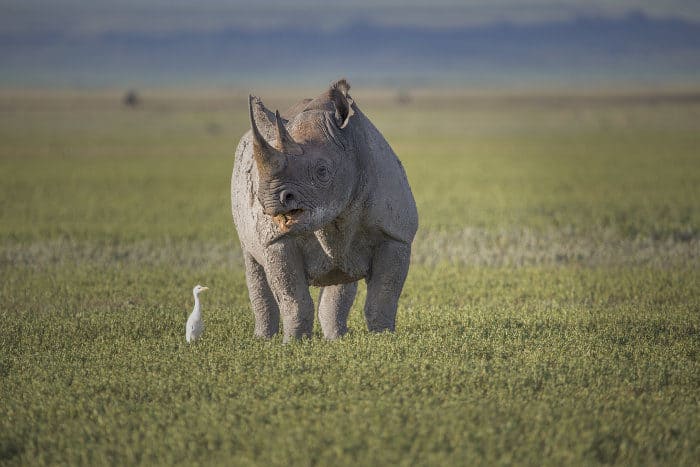
On every African safari it is important to maximise the early morning hours. This is when it is cooler and animals are most active. This advice is absolutely essential for a Ngorongoro Crater safari.
Lions are prowling in the morning hours and you should see either a hunt or a carcass. Black rhinos browse in the open but are rarely spotted after 9 am. Animals are very active here between 6 am and 9 am.
By 10 am most of the really interesting stuff has ended. Large mammals are resting and ungulates are grazing in peace.
Like most other safari destinations, there is also a surge of life in the late afternoon. However, early mornings are better than late afternoons in Ngorongoro Crater. Put simply, there is much more going on.
So when is Ngorongoro Crater at its busiest? From 9 am to 2 pm! Completely the worst times to be on safari!
Vehicles start crowding the crater floor. Animals retreat even further and seek respite from the noise. By midday there is little but vehicles. It is a theme park and the wildlife is squeezed out.
But why? Knowing the answer to this is essential to planning the best possible Ngorongoro Crater safari.
Choosing where to stay in Ngorongoro
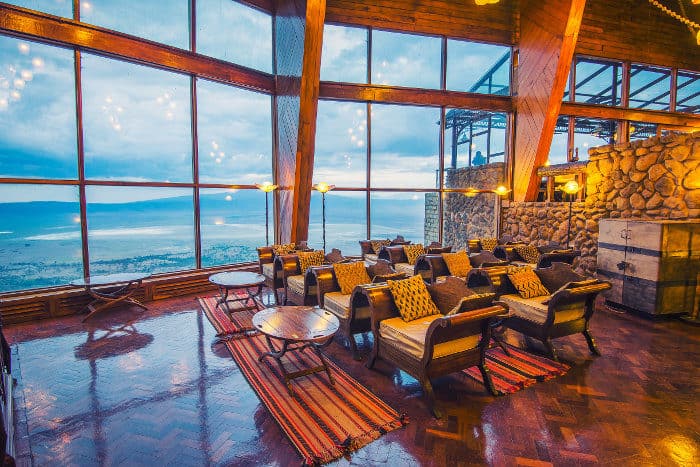
Listen up, because this part is very important.
There is nowhere to stay on the crater floor. Instead, safari lodges are perched around the crater rim. There is also a public campsite on the crater rim and some cheaper lodges inside Ngorongoro Conservation Area, away from the rim.
Accommodation is significantly cheaper outside the conservation area, notably the small and nondescript town of Karatu.
For the best Ngorongoro Crater game drive you need be at the crater gate when it opens, at sunrise.
Remember, there are only two routes down into the crater. Also remember, you are not allowed to drive around Ngorongoro Conservation Area in the dark.
The closer you stay to the crater gate the earlier you can go on safari. Ngorongoro Serena Safari Lodge and the public Simba campsite are the two closest options. However, anywhere to the west of the crater is a good choice as you can set off at first light and still be in the crater at sunrise.
(Author’s note – Ngorongoro Rhino Lodge is excellent value in comparison to lodges located on the crater rim. It does not have incredible views but is comfortable and only a ten-minute drive to the crater gate).
Staying on the northeast of the crater is also an option but note that lodges in this area are astonishingly expensive.
Anyone staying in Karatu will first have to get through the Ngorongoro Conservation Area gate (queuing for permits takes over an hour in peak season), then drive to the crater entrance. If you are fast you can be on the crater floor by 8 am, which is already too late.
Choosing a safari operator

Ngorongoro Crater is magical at dawn. Mist meanders through the caldera and all the animals are out exploring. There are few other vehicles and an incredible sense of a utopian wildlife world.
By 9 am it starts getting crowded. By 11 am there are very few animals in the open, but up to 100 vehicles roaming around.
Some safari operators are genuinely interested in delivering the best possible safari for their clients. They will focus on your wildlife experience and create the program accordingly.
Other safari operators will take you to the different parks and reserves, without thought of what is best for seeing wildlife. They can offer the cheapest prices by using accommodation in Karatu.
You can easily tell safari operators apart. Just ask them what the program will be for visiting Ngorongoro Crater, including where you will stay the night before, and what time you will visit the crater.
In fact, these questions are an excellent way to discern the quality of a safari operator before you travel.
The alternative to an overland safari is to arrange transport to a Ngorongoro Crater lodge. You can then go on safari with a guide and vehicle from the lodge. This is ideal if you only plan to visit Ngorongoro and not nearby destinations.
It is also a good wildlife option because guides from the lodge will have a better understanding of the crater floor, in comparison to guides who take you to many different destinations.
Making it Happen
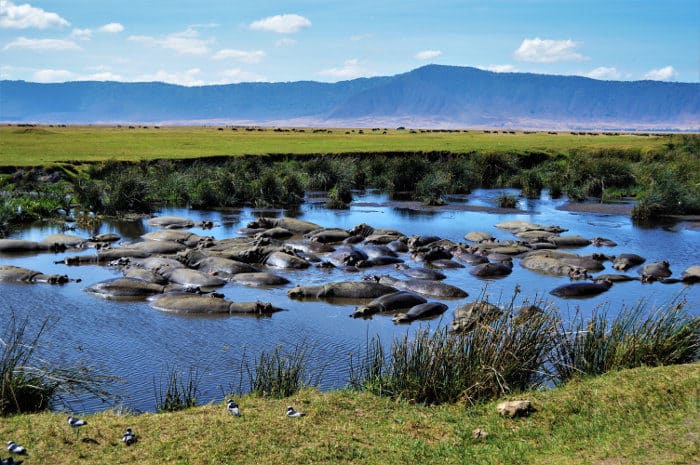
While there are more and more vehicles and visitors to Ngorongoro, the fundamentals of timing mean the crater experience can be just like it has been.
Through the night it is wild and unknown, a wildlife utopia free from human eyes. For two or three brief dawn hours Ngorongoro Crater is the most magical place in Africa.
Then comes the chaos, especially during the peak months for a Tanzania safari (notably June to August).
You don’t need a definitive guide to this volcanic caldera. All you need is a safari program that gets you onto the crater floor before everyone else.
Once down in the crater an unpredictable wildlife world will take over. Lions, hyenas, zebra, wildebeest, elephants, buffalo, and all those mysterious scenes disconnected from human hand.
You only need one morning game drive to fully experience Ngorongoro Crater. This usually equates to two nights in Ngorongoro Conservation Area. Four hours is plenty to drive around it all. Then you need an afternoon to recollect what you have experienced.
Make it happen in the right way and you will experience Africa unchanged. Do it the wrong way and you are just another visitor making noise, at the only time when Ngorongoro Crater is not a wildlife realm.



